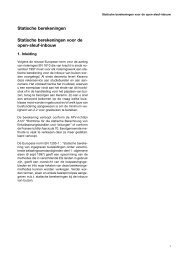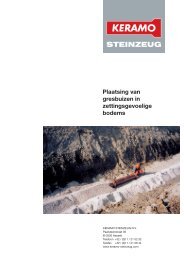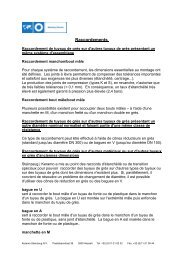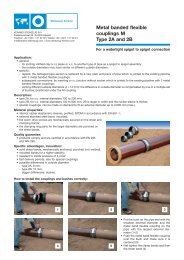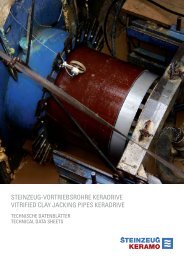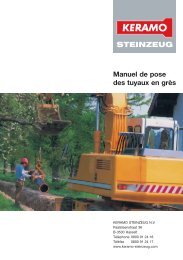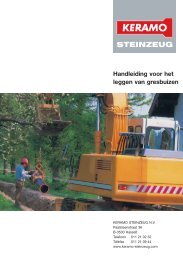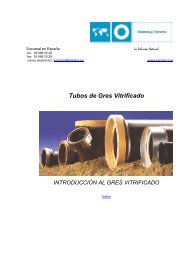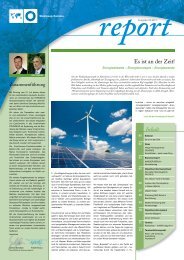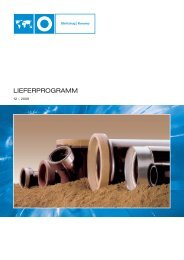mohring engels.indd - Keramo Steinzeug
mohring engels.indd - Keramo Steinzeug
mohring engels.indd - Keramo Steinzeug
Create successful ePaper yourself
Turn your PDF publications into a flip-book with our unique Google optimized e-Paper software.
4. Selection criteria for jacking<br />
systems<br />
As soon as different systems are available on the market<br />
the question of which it is advisable to use for which<br />
purpose arises. There is no single answer to this<br />
question since all systems have both advantages and<br />
disadvantages, the scope for use is wide and the constraints<br />
in problem definitions are often very complex.<br />
It is important that the promoter/client provides potential<br />
contractors with not only a comprehensively documented<br />
unambiguous plan but also, specifically, the most<br />
exact possible and sufficient data on the geology and<br />
soil mechanics of the line to be followed by the sewer<br />
and on the groundwater conditions. The decision on the<br />
jacking system to be used should – for purposes of<br />
rational spreading of risks – ultimately be left to the<br />
bidder, i.e. the subsequent construction company.<br />
Capital outlay for thrust-bore pipe-jacking systems is<br />
lower. They need less space and personnel, yielding<br />
time saving of up to 35% over shield jacking systems for<br />
setting-up the site.<br />
The following two tables analysing advance rates<br />
attained, including set-up time, yield further information.<br />
The first comparison shows a distinct decline in average<br />
advance rates for thrust-bore pipe-jacking systems as<br />
nominal size increases. For > DN 500 they drop to about<br />
66% / 71% of the rates attained for DN 250.<br />
In contrast, with shield pipe jacking, i.e. with hydraulic<br />
conveying, advance rates including set-up time are<br />
found to be more-or-less independent of nominal size.<br />
BWB: thrust-bore pipe jacking, average<br />
advance per 8 hours in metres<br />
Advance Advance<br />
with set-up time<br />
DN 250 9,93 6,08<br />
DN 300 8,61 5,20<br />
DN 400 8,32 4,91<br />
DN 500 8,46 5,00<br />
>DN 500 6,58 4,34<br />
The analyses relate to approximately 167,000 metres’<br />
total advance up to the end of 1994 in Berlin. It should<br />
be noted that the figures naturally reflect all local<br />
constraints, but also the skill and motivation of the personnel<br />
on site and the whole ethos of the executing<br />
company.<br />
Micro-tunnelling Page 15<br />
BWB: Shield pipe jacking, average advance<br />
per 8 hours in metres<br />
Advance Advance<br />
with set-up time<br />
DN 250 10,83 6,19<br />
DN 300 9,82 5,41<br />
DN 400 11,22 6,52<br />
DN 500 11,91 6,69<br />
DN 600 10,82 6,30<br />
DN 800 11,01 6,00<br />
DN 1000 11,65 6,71<br />
DN 1200 11,99 7,23<br />
The trend towards distinctly higher rates with shield pipe<br />
jacking systems at nominal sizes DN 400 is however<br />
conspicuous. This is partly due to the fact that at larger<br />
nominal sizes continuous transport of soil by flush-conveying<br />
is clearly superior to that using buckets. Moreover,<br />
the higher extraction and comminution rate has<br />
particularly beneficial effects where the ground is difficult.<br />
The constantly direct drive of the cutting head, the<br />
smaller losses compared with auger drive and the possibility<br />
thus afforded of driving greater lengths also make<br />
themselves felt in favour of auger systems.<br />
Selection of a jacking system with the particular<br />
extracting tools needed is however most strongly<br />
influenced by the geological conditions and groundwater<br />
level. See in this connection a publication by W. Becker<br />
(Berlin) on ”Scope and limits of micro-tunnelling taking<br />
extraction tools into account” (offprint from the journal<br />
”Tiefbau” , Vol. 7/1996, obtainable from <strong>Steinzeug</strong><br />
GmbH, Max-Planck-Strasse 6, 50858 Cologne). Taking<br />
as its basis the soil classifications of the General Technical<br />
Contract Terms (ATV), DIN 18319, VOB Part C, this<br />
article makes recommendations on selecting suitable<br />
jacking systems.<br />
5. Micro-tunnelling applications<br />
With the jacking systems available on the market construction<br />
orders for all nominal sizes used in sewage<br />
systems for both extension and renewal purposes are<br />
possible. Oval cross-sections too, which are enjoying<br />
something of a renaissance in waste-water engineering<br />
by virtue of their hydraulic advantages, can be jacked<br />
underground. Their external profile must of course have<br />
a circular cross-section, and precise adherence to the<br />
pipeline invert must be ensured. This requires roll-free<br />
jacking, which can be achieved if adjacent pipes are<br />
joined with shearing pins and machines with flush-conveying<br />
and thus cutting heads rotating clockwise and<br />
anti-clockwise are used.





